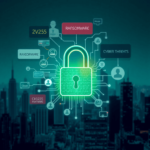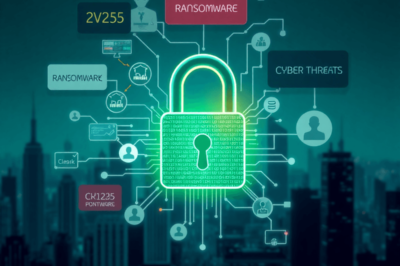
Introduction
The cybersecurity landscape of 2025 presents unprecedented challenges for businesses worldwide. With cyber incidents costing organizations an average of $4.88 million per data breach, protecting digital assets has become a critical priority.
Your business faces sophisticated threats from multiple directions:
- AI-powered attacks that adapt and evolve
- Ransomware groups targeting critical infrastructure
- Advanced phishing schemes exploiting human vulnerabilities
- Credential theft compromising user accounts
- Insider risks from within your organization
The global cost of cybercrime is projected to reach a staggering $10.5 trillion annually by 2025. This figure represents both direct financial losses and long-term reputational damage that can cripple businesses of any size.
In this comprehensive guide, you’ll discover:
- Current cybersecurity threats targeting businesses
- Essential security measures to protect your organization
- Practical strategies for employee training and awareness
- Tools and technologies to strengthen your security posture
- Steps to create effective incident response plans
Your organization’s survival depends on understanding and implementing robust cybersecurity practices. Let’s explore the strategies you need to safeguard your business in 2025.
Understanding Cybersecurity Threats
The cybersecurity landscape of 2025 presents businesses with sophisticated threats that can cripple operations and compromise sensitive data. Let’s examine these threats in detail to help you build effective defense strategies.
1. Ransomware Attacks
Ransomware represents one of the most devastating cyber threats to businesses. These malicious programs encrypt your company’s data, making it inaccessible until a ransom payment is made to the attackers.
How Ransomware Works:
- Initial infection through email attachments, malicious links, or compromised websites
- Silent encryption of files across network drives
- Display of ransom demands, typically in cryptocurrency
- Threat of data deletion or public release if payment isn’t made
Current Trends:
- Average ransom demands have reached $850,000
- 60% of attacks now include data theft before encryption
- Healthcare and financial sectors face the highest targeting rates
- Double extortion tactics combine file encryption with data leaks
Real-World Impact:
“A mid-sized manufacturing company lost $2.3 million in revenue during a week-long ransomware incident in 2024. The attack encrypted their production scheduling system, forcing a complete shutdown of operations.“
Notable Cases:
- Global Tech Solutions: Lost access to customer databases for 12 days
- MediCare Hospital Network: Paid $3.2M after patient records were encrypted
- Financial First Credit Union: Suffered 48-hour service disruption affecting 50,000 customers
The sophistication of ransomware attacks continues to evolve, with attackers using AI-powered tools to identify high-value targets and optimize their attack strategies. Many cybercriminal groups now operate like legitimate businesses, complete with customer service departments to facilitate ransom payments.
Prevention Metrics:
- 92% of successful attacks exploit unpatched vulnerabilities
- Regular backups reduce recovery time by 65%
- Employee training decreases infection risks by 70%
2. Phishing Attacks
Phishing attacks remain a persistent threat in 2025, with cybercriminals using sophisticated social engineering tactics to deceive employees and gain unauthorized access to business systems. These attacks typically involve:
- Email Impersonation: Attackers create convincing replicas of legitimate business communications
- Spear Phishing: Targeted attacks using personalized information about specific employees
- Vishing: Voice-based phishing calls that manipulate victims into revealing sensitive data
- SMS Phishing: Text messages containing malicious links or requests for information
Recent statistics reveal the growing sophistication of phishing attempts:
- 83% of organizations experienced phishing attacks in 2024
- 1 in 3 employees click on suspicious links within the first hour of receiving them
- 65% of phishing attempts now bypass traditional email security measures
Real-World Impact: A notable case involved Tech Corp International, where a single successful phishing email led to a $2.7 million loss. The attacker posed as the CEO, requesting an urgent wire transfer from the finance department. This incident highlighted the need for robust verification protocols.
Businesses face these common phishing tactics:
- Urgent Payment Requests: Messages claiming immediate action required for pending payments
- Password Reset Alerts: Fake security notifications requesting credential updates
- Cloud Service Notifications: Impersonated messages from popular business platforms
- Invoice Scams: Fraudulent billing documents containing malicious attachments
The success rate of phishing attacks has increased by 47% since 2023, with cybercriminals using AI to create highly convincing fake communications. Small businesses prove particularly vulnerable, with 60% of attacked companies going out of business within six months of a successful breach.
3. Credential Theft
Credential theft is a serious threat to business security. It allows cybercriminals to gain unauthorized access to sensitive systems and data, leading to significant financial losses, data breaches, and reputational damage.
Common Methods of Credential Theft:
- Keylogging Software: Malicious programs that record keystrokes to capture login credentials
- Man-in-the-Middle Attacks: Intercepting communications between users and legitimate websites
- Credential Stuffing: Using stolen username/password combinations across multiple platforms
- Social Engineering: Manipulating employees into revealing their login information
- Database Breaches: Extracting stored credentials from compromised databases
Business Impact:
- Average cost of credential theft: $2.9 million per incident
- 61% of data breaches involve stolen credentials
- Recovery time: 250+ hours for IT teams
Prevention Strategies:
- Implement biometric verification
- Use hardware security keys
- Enable time-based one-time passwords (TOTP)
- Password Management
- Deploy enterprise password managers
- Enforce strong password policies
- Regular password rotation schedules
- Access Control
- Implement least-privilege access
- Regular access reviews
- Automated account deactivation
Detection Methods:
- Monitor for unusual login patterns
- Track multiple failed login attempts
- Implement behavioral analytics
- Deploy credential monitoring services
Organizations using these prevention strategies report 73% fewer successful credential theft incidents. Regular security audits combined with employee training significantly reduce the risk of credential-based attacks.
4. Insider Threats
Insider threats are a unique challenge for businesses because they come from within the organization’s trusted network. There are two main types of insider threats:
1. Malicious Insider Threats
These are individuals within the organization who intentionally cause harm or compromise security. Examples include:
- Disgruntled employees seeking revenge
- Staff members selling sensitive data
- Individuals working with external threat actors
- Personnel engaging in corporate espionage
2. Inadvertent Insider Threats
These threats occur when employees unknowingly compromise security due to lack of awareness or negligence. Examples include:
- Employees falling victim to social engineering
- Accidental data exposure through misconfigurations
- Improper handling of sensitive information
- Use of unauthorized applications or services
The Role of Employee Awareness
Employee awareness is crucial in defending against insider threats. Regular security briefings can help staff recognize potential risks and understand their role in maintaining organizational security. These sessions should cover:
- Data handling protocols
- Security policy compliance
- Recognition of suspicious behavior
- Proper incident reporting procedures
Monitoring Systems for Insider Threats
Businesses also implement advanced monitoring systems to detect and prevent insider threats:
1. Technical Controls
These are tools and technologies used to monitor user activities and identify potential security breaches. Examples include:
- User behavior analytics (UBA)
- Data loss prevention (DLP) tools
- Access logging and auditing
- Network traffic monitoring
- File activity tracking
These systems create baseline behavior profiles for users and flag any unusual activities that might indicate a security breach.
2. AI Algorithms for Threat Detection
In addition to technical controls, advanced AI algorithms are employed to analyze patterns in real-time and identify potential threats before they escalate into security incidents. This proactive approach enhances the effectiveness of monitoring systems in combating insider threats.
5. AI-Driven Attacks
Artificial Intelligence has changed the game for cybercriminals, enabling them to create complex threats that can easily bypass traditional security measures. Here’s how they’re using AI to their advantage:
1. Automating Attack Patterns
With the help of AI, cybercriminals can now automate various aspects of their attacks, making them faster and more efficient. Some examples include:
- Rapidly identifying weaknesses in computer systems
- Developing malware that can learn and adapt to existing security measures
- Using pattern recognition techniques to automatically guess passwords
2. Generating Convincing Fake Content
AI is also being used to create realistic-looking fake content that can trick individuals into revealing sensitive information or performing actions unknowingly. This includes:
- Creating deepfake videos to impersonate executives
- Crafting phishing emails that are indistinguishable from genuine messages using AI-generated text
- Cloning voices for social engineering attacks
Recent incidents have shown just how effective these AI-powered attacks can be. In one case in 2024, cybercriminals managed to steal $3.2 million from a major financial institution by using AI-generated voice clones to authorize fraudulent wire transfers.
The availability of AI-as-a-Service platforms has made it easier for cybercriminals to access advanced attack tools without requiring extensive technical knowledge. They can now rent pre-trained AI models to:
- Launch targeted phishing campaigns
- Create personalized social engineering attacks
- Develop polymorphic malware that changes its appearance to evade detection
Experts believe that by 2026, these AI-driven attacks will become even more autonomous, capable of:
- Spreading across networks on their own
- Adapting their attack strategies in real-time based on the defenses they encounter
- Evading detection through intelligent behavior modification techniques
To combat these evolving threats, businesses need to implement defense systems powered by artificial intelligence (AI) that can match the sophistication of modern attacks.
6. Distributed Denial of Service (DDoS) Attacks
DDoS attacks are a major threat to businesses because they can overload network resources and make them inaccessible to legitimate users. These attacks usually involve multiple compromised computers working together as a botnet to flood the target systems with massive amounts of traffic.
Common DDoS Attack Types:
- Volumetric Attacks: These attacks use large amounts of traffic to saturate the bandwidth.
- Protocol Attacks: The target server resources and firewalls are targeted in these attacks.
- Application Layer Attacks: Specific web applications are disrupted by focusing on them.
Recent high-profile incidents highlight the growing sophistication of DDoS attacks. In late 2024, a major financial institution faced a 2.3 Tbps attack that disrupted online banking services for 48 hours. The gaming industry saw multiple attacks during peak gaming seasons, with attackers demanding ransom payments to stop the disruptions.
Effective DDoS Mitigation Strategies:
- Deploy traffic monitoring systems to detect unusual patterns
- Implement cloud-based DDoS protection services
- Use traffic filtering and rate limiting
- Set up network redundancy with multiple data centers
- Create blackhole routing protocols for suspicious traffic
Businesses can strengthen their DDoS resilience by partnering with content delivery networks (CDNs) and implementing automated response systems. These protective measures help maintain service availability during attack attempts and minimize potential downtime costs.
Best Cybersecurity Practices for Businesses in 2025
The cybersecurity landscape demands a comprehensive approach to protect business assets and data. Here’s what successful organizations implement to strengthen their security posture:
1. Employee Training and Awareness Programs
Your employees represent both your first line of defense and potential vulnerability in cybersecurity. A robust security awareness training program helps create a human firewall against cyber threats.
Key Components of Effective Training Programs:
- Simulated Phishing Attacks: Regular tests with mock phishing emails, performance tracking and improvement metrics, targeted training for employees who fall for simulations.
- Interactive Learning Modules: Role-specific security training, real-world scenario exercises, hands-on practice with security tools.
- Security Awareness Platforms: KnowBe4, Proofpoint Security Awareness Training, SANS Security Awareness.
Training Methods That Work:
- Microlearning Sessions: 5-10 minute daily security tips, mobile-friendly content delivery, quick knowledge checks.
- Gamification Elements: Security awareness leaderboards, achievement badges for completing training, team-based security challenges.
Measuring Training Effectiveness:
- Track reduction in security incidents
- Monitor phishing simulation success rates
- Assess employee security behavior changes
- Document policy compliance improvements
Training Topics to Cover:
- Password hygiene and management
- Social engineering recognition
- Safe browsing practices
- Mobile device security
- Data handling procedures
- Incident reporting protocols
Regular security awareness training reduces human error-related incidents by 70%. Organizations implementing comprehensive training programs see a significant decrease in successful cyber attacks.
2. Data Security Tools Implementation
Data security tools are crucial for your business’s cybersecurity infrastructure in 2025. A strong security toolkit includes several important components to safeguard your sensitive information.
Essential Security Tools for 2025:
- Encryption SoftwareEnd-to-end encryption for data in transit
- At-rest encryption for stored information
- Hardware encryption for physical devices
- Data Loss Prevention (DLP)Real-time monitoring of data movement
- Automated classification of sensitive information
- Policy enforcement for data handling
- Security Information and Event Management (SIEM)24/7 system monitoring
- Threat detection and analysis
- Automated incident reporting
- Cloud Access Security Broker (CASB)Shadow IT discovery
- Data security policies across cloud services
- Risk assessment for cloud applications
Advanced Protection Features:
- AI-powered threat detection systems identify anomalies in real-time
- Quantum-resistant encryption protocols safeguard against future threats
- Automated backup systems with ransomware protection
- Blockchain-based audit trails for sensitive data access
These tools work together to create multiple layers of protection. Your security infrastructure needs regular updates to maintain effectiveness against emerging threats. Implementing these tools requires careful consideration of your business needs, regulatory requirements, and resource capabilities.
3. Identity and Access Management (IAM)
Identity and Access Management is a crucial defense mechanism that protects your systems from unauthorized access and credential theft. A strong IAM strategy uses multiple layers of security to safeguard your business assets.
Key Components of Modern IAM:
- Multi-Factor Authentication (MFA): This adds an extra layer of security by requiring users to provide multiple forms of verification, such as biometric verification, hardware security keys, time-based one-time passwords, or push notifications to authenticated devices.
- Zero Trust Architecture: With this approach, you continuously verify users, apply least privilege access principles, conduct regular access reviews, and monitor sessions to ensure that only authorized individuals can access your systems.
Access Control Measures:
- Role-Based Access Control (RBAC): This method involves defining predefined user roles, automating permission management, and conducting regular role audits to ensure that users only have access to the resources they need.
- Privileged Access Management (PAM): PAM focuses on managing and securing privileged accounts by implementing just-in-time access, password vaulting, session recording, and admin activity logging.
Implementation Best Practices:
- Integrate Single Sign-On (SSO) solutions for seamless user authentication across multiple applications.
- Deploy adaptive authentication based on risk levels to dynamically adjust security measures based on the context of each login attempt.
- Implement automated user provisioning/deprovisioning processes to ensure that access rights are granted or revoked promptly when employees join or leave the organization.
- Maintain detailed access logs for audit trails to track who accessed what resources and when.
- Conduct regular access reviews to validate that users still require their assigned permissions.
Advanced IAM systems now incorporate AI-driven behavioral analytics to detect suspicious login patterns and potential credential compromise. These systems analyze user behavior patterns, location data, and device information to create risk-based authentication protocols.
4. Network Security Measures
Network security is the foundation of your business’s digital defense strategy in 2025. A strong network security system uses multiple layers of protection to keep your organization’s data and systems safe.
Essential Security Components
- Next-Generation Firewalls (NGFW): These firewalls go beyond traditional methods by inspecting data packets deeply, filtering at the application level, and integrating real-time threat intelligence for proactive defense.
- Advanced Intrusion Detection Systems (IDS): Powered by artificial intelligence, these systems detect unusual patterns in network behavior, analyze user and entity behavior, and automatically respond to potential threats.
- Network Segmentation: By dividing your network into smaller segments, you can have more precise control over traffic flow, implement virtual LANs (VLANs) for better organization, and adopt a zero trust approach where every device is treated as untrusted until proven otherwise.
Monitoring and Management
- Continuous monitoring of network traffic around the clock
- Immediate identification and response to threats
- Automated systems for managing software updates
- Regular scans to identify vulnerabilities in your network
Security Protocols
- Implementation of TLS 1.3 encryption for secure communication
- Proper configuration of DNS settings to prevent attacks
- Use of Virtual Private Networks (VPNs) for secure remote connections
- Control over who can access your network through Network Access Control (NAC)
Performance Optimization
- Distribution of incoming traffic across multiple servers using load balancing techniques
- Management of network resources to prioritize certain types of traffic with Quality of Service (QoS)
- Monitoring and improvement of bandwidth usage to ensure smooth operations
- Planning for backup systems in case of network failures
These measures create a comprehensive defense system that adapts to emerging threats while maintaining optimal network performance. Regular updates and maintenance of these security components ensure your network remains resilient against evolving cyber threats.
5. Regular Risk Assessments & Incident Response Planning
Regular risk assessments are essential for a strong cybersecurity strategy. Organizations should conduct thorough evaluations at least once a year to identify potential weaknesses in their infrastructure.
Key Parts of a Complete Risk Assessment:
- Asset Inventory Analysis
- Threat Identification
- Vulnerability Scanning
- Impact Assessment
- Risk Prioritization
- Control Effectiveness Review
The results from these assessments help organizations use their resources wisely and put in place specific security measures where they are most needed.
Creating an Effective Incident Response Plan:
- Detection and AnalysisImplement automated detection systems
- Establish incident severity levels
- Define clear escalation procedures
- Containment ProtocolsIsolate affected systems
- Preserve evidence
- Document incident timeline
- Eradication and RecoveryRemove threat actors
- Patch vulnerabilities
- Restore systems from clean backups
- Post-Incident ActivitiesConduct root cause analysis
- Update security controls
- Revise response procedures
Organizations should assign an Incident Response Team (IRT) with clearly defined roles and responsibilities. This team needs access to necessary tools and resources to carry out the response plan effectively.
Risk Assessment Best Practices:
- Conduct assessments after significant infrastructure changes
- Use both automated and manual testing methods
- Include third-party vendor evaluations
- Document all findings and remediation steps
- Set clear timelines for addressing identified vulnerabilities
A well-structured incident response plan enables organizations to act swiftly during security breaches. Regular testing through tabletop exercises helps teams stay prepared and identifies gaps in the response strategy.
Documentation Requirements:
- Detailed incident response procedures
- Contact information for key stakeholders
- System recovery priorities
- Communication templates
- Legal and regulatory compliance requirements
Organizations should combine their risk assessment findings with their incident response planning. This combination ensures that high-risk areas receive priority attention during security incidents and that response procedures align with the organization’s specific threat landscape.
Regular updates to both risk assessments and incident response plans ensure they remain relevant as technology evolves and new threats emerge. These updates should include lessons learned from previous incidents, ensuring continuous improvement in the organization’s security posture.
Conclusion
The cybersecurity landscape of 2025 demands unwavering attention and strategic investment from businesses of all sizes. Your organization’s survival depends on building robust defense mechanisms against evolving digital threats.
Key Actions for Your Business:
- Allocate dedicated budget for cybersecurity initiatives
- Implement comprehensive security frameworks
- Maintain regular training programs
- Stay informed about emerging threats
- Build partnerships with cybersecurity experts
The cost of cyber incidents continues to rise, with data breaches averaging $4.88 million. This investment in protection pales in comparison to the potential losses from successful attacks.
The future brings both challenges and opportunities. AI-powered threats will become more sophisticated, yet advanced security tools will offer enhanced protection. Your business’s security posture must evolve alongside these changes.
Remember: Cybersecurity isn’t a one-time investment—it’s an ongoing commitment to protecting your business, employees, and customers in an interconnected digital world.
FAQs (Frequently Asked Questions)
What are the key cybersecurity threats businesses face in 2025?
In 2025, businesses face a range of cybersecurity threats including ransomware attacks, phishing schemes, credential theft, insider threats, AI-driven attacks, and Distributed Denial of Service (DDoS) attacks. Each of these threats poses significant risks to financial and reputational stability.
How can businesses protect themselves from ransomware attacks?
To protect against ransomware attacks, businesses should implement strong data encryption practices, conduct regular backups, and educate employees about recognizing potential threats. It’s also essential to have an incident response plan in place to address any breaches quickly.
What role does employee training play in cybersecurity?
Ongoing employee training is crucial for enhancing cybersecurity awareness among staff. Effective training programs help employees recognize potential threats such as phishing attempts and insider threats, thereby reducing the likelihood of successful cyberattacks.
What are some best practices for data security in businesses?
Best practices for data security include implementing multi-factor authentication (MFA), utilizing encryption tools, establishing a zero trust architecture, conducting regular cybersecurity risk assessments, and developing an incident response plan (IRP) to manage potential breaches.
What is the significance of identity and access management (IAM) in preventing cyber incidents?
Identity and Access Management (IAM) is vital for preventing credential theft and unauthorized access. By ensuring that only authorized users have access to sensitive data and systems, IAM helps mitigate risks associated with insider threats and external attacks.
How can businesses mitigate the risks associated with DDoS attacks?
To mitigate DDoS attack risks, businesses should employ network protection strategies such as traffic filtering, rate limiting, and deploying intrusion detection systems (IDS). Additionally, having a robust incident response plan can help manage the impact of such attacks effectively.
Powered by junia.ai. To remove branding, please upgrade to a paid plan.










